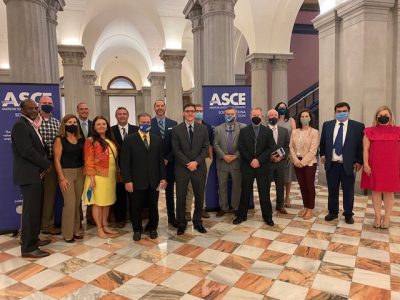On Wednesday, September 8, the South Carolina Section of ASCE unveiled the 2021 Report Card for South Carolina’s Infrastructure, the first report card ever issues by the South Carolina Section. The report assigned the state’s systems a cumulative grade of “D+” which is below the national grade of “C-.”
The report analyzed eight categories of infrastructure pertinent to South Carolina: aviation (D+), bridges (C), dams (D), drinking water (D+), ports (B), roads (D), transit (D+) and wastewater (D). The grades were unveiled at the S.C. State House in front of a live audience which included members of the press. ASCE South Carolina Section President Jonathan Thrasher, Past-President Jonathan Ard, and President-Elect Ryan Harvey presented the findings.

(From left to right): Jonathan Ard, Jonathan Thrasher, Ryan Harvey.
The state’s dams, drinking water and wastewater systems have undergone significant upgrades in recent years, with projects being completed or developed so rapidly that the publicly available data has not yet caught up to reflect the level of expansion and modernization each system has undergone. Despite these improvements, each water infrastructure sector faces significant challenges from severe storms and decades of underinvestment, along with increased demand stemming from a booming population.
The report found that South Carolina’s transportation network is struggling. The state’s roads (D) and bridges (C) face an estimated funding gap of $43 billion by 2040, and more than 50% of roads are in poor condition. The state’s roads also have the highest fatality rate in the U.S. at 1.72 per 100 million vehicle miles traveled (VMT). Nearly 11% of South Carolina bridges are structurally deficient – more than the 7.5% national average – and more bridges are rated in fair (47%) than good (45%) condition.
However, the state has taken strides towards addressing these issues, raising its gas tax by 12 cents per gallon over six years starting in 2017 to generate more than $625 million in new annual revenue; the state also adopted the Target Zero vision for reducing fatalities. SCDOT’s 10-year Targeted Asset Management to realize life-cycle management goals for highway assets is in its 4th year and is ahead of schedule for bridge replacements.
The star of the report card is the ports (B) category, with the highest grade of all eight sectors. S.C. Ports is a top-10 container port in the United States, responsible for 1-in-10 South Carolina jobs and generating more than $63 billion in economic output for the state. As the Southeastern economy continues to grow exponentially, S.C. Ports has seen cargo volumes double in the past 10 years. Ocean carriers are deploying larger vessels to keep up with demand, which requires deeper harbors and increased port capacity.
The South Carolina Ports Authority, the state of South Carolina, federal government and industry partners are continuously investing in the port facilities with $2.6 billion invested through fiscal year 2022. The $2.6 billion investment will double container capacity upon final buildout of the new High K. Leatherman Sr. Terminal in Charleston and deepen the harbor to 52 feet so that mega container ships may access terminals any time, regardless of tides.
The report also includes calls to action to raise the grades, such as:
- The federal government should fully fund authorized infrastructure programs to invest in South Carolina’s aging infrastructure to support the growing population.
- Design, operate, maintain and expand infrastructure using consensus-based codes and standards, focusing on resilience and life cycle cost as the best measures of infrastructure performance and best use of taxpayer dollars.
- Establish funding and grants to assist programs that enhance the quality of public service in areas such as drinking water, wastewater, regional transit, and aviation. These programs would consist of utility consolidation, resilience improvements, capacity related infrastructure upgrades, and technical career training that retains South Carolina’s talent.






